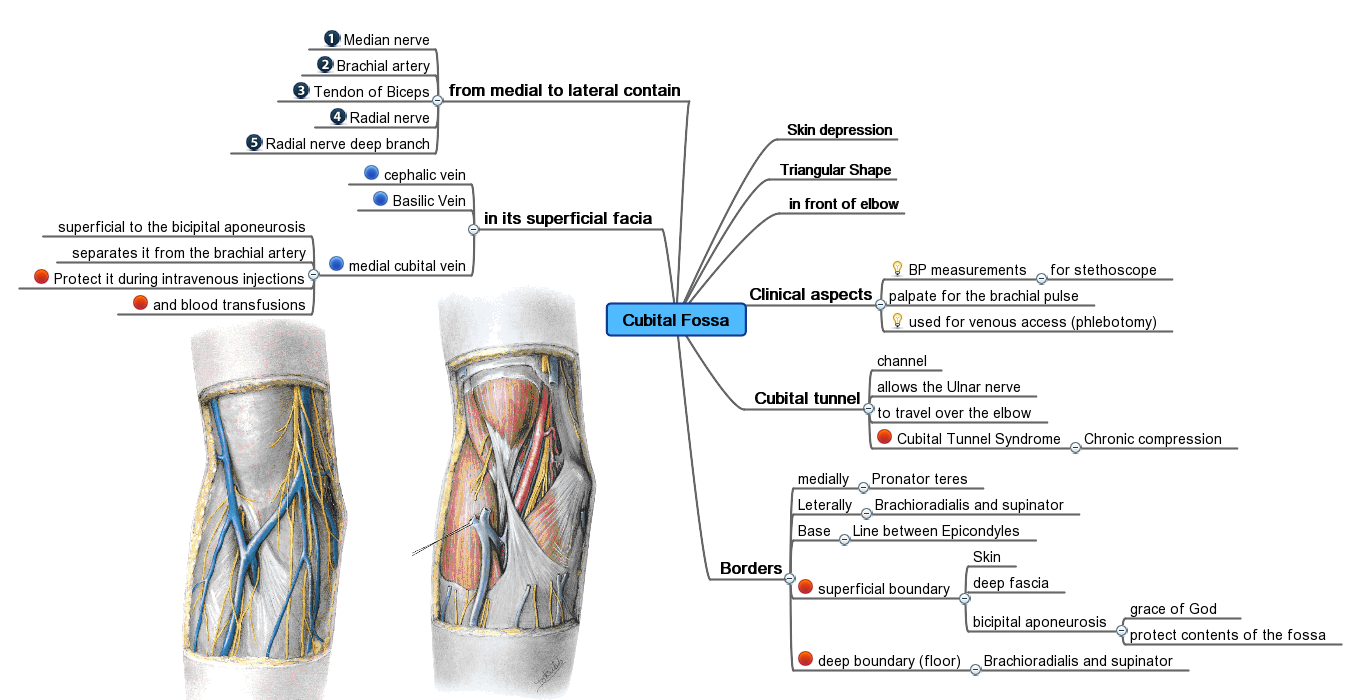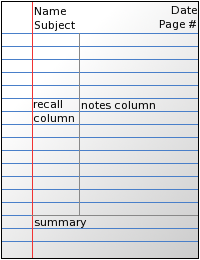|
Mind-map
A mind map is a diagram used to visually organize information into a hierarchy, showing relationships among pieces of the whole. It is often created around a single concept, drawn as an image in the center of a blank page, to which associated representations of ideas such as images, words and parts of words are added. Major ideas are connected directly to the central concept, and other ideas branch out from those major ideas. Mind maps can also be drawn by hand, either as "notes" during a lecture, meeting or planning session, for example, or as higher quality pictures when more time is available. Mind maps are considered to be a type of spider diagram. Origins Although the term "mind map" was first popularized by British popular psychology author and television personality Tony Buzan, the use of diagrams that visually "map" information using branching and radial maps traces back centuries. These pictorial methods record knowledge and model systems, and have a long history in ... [...More Info...] [...Related Items...] OR: [Wikipedia] [Google] [Baidu] |
MindMeister
MindMeister is an online mind mapping application that allows its users to visualize, share and present their thoughts via the cloud. MindMeister was launched in 2007 by MeisterLabs GmbH, a software company founded by Michael Hollauf and Till Vollmer. After 10 years in the market, MindMeister has more than 7 million users who created more than a billion ideas to date. Overview MindMeister provides a way to visualize information in mind maps utilizing user modeling, while also providing tools to facilitate real-time collaboration, coordinate task management and create presentations. MindMeister is based on a freemium model, with a basic account available free of charge, providing limited functionality. The commercial model is built upon 4 different pricing levels with a choice of monthly or yearly subscription-charges. For use in the education sector, 3 different functional levels are available. The aim of MindMeister is to enable individuals to collaborate on a mind map, wher ... [...More Info...] [...Related Items...] OR: [Wikipedia] [Google] [Baidu] |
Concept Map
A concept map or conceptual diagram is a diagram that depicts suggested relationships between concepts. Concept maps may be used by instructional designers, engineers, technical writers, and others to organize and structure knowledge. A concept map typically represents ideas and information as boxes or circles, which it connects with labeled arrows, often in a downward-branching hierarchical structure but also in free-form maps. The relationship between concepts can be articulated in '' linking phrases'' such as "causes", "requires", "such as" or "contributes to". The technique for visualizing these relationships among different concepts is called ''concept mapping''. Concept maps have been used to define the ontology of computer systems, for example with the object-role modeling or Unified Modeling Language formalism. Differences from other visualizations * '' Topic maps'': Both concept maps and topic maps are kinds of knowledge graph, but topic maps were developed ... [...More Info...] [...Related Items...] OR: [Wikipedia] [Google] [Baidu] |
Concept Maps
A concept map or conceptual diagram is a diagram that depicts suggested relationships between concepts. Concept maps may be used by instructional designers, engineers, technical writers, and others to organize and structure knowledge. A concept map typically represents ideas and information as boxes or circles, which it connects with labeled arrows, often in a downward-branching hierarchical structure but also in free-form maps. The relationship between concepts can be articulated in '' linking phrases'' such as "causes", "requires", "such as" or "contributes to". The technique for visualizing these relationships among different concepts is called ''concept mapping''. Concept maps have been used to define the ontology of computer systems, for example with the object-role modeling or Unified Modeling Language formalism. Differences from other visualizations * '' Topic maps'': Both concept maps and topic maps are kinds of knowledge graph, but topic maps were develo ... [...More Info...] [...Related Items...] OR: [Wikipedia] [Google] [Baidu] |
Note-taking
Note-taking (sometimes written as notetaking or note taking) is the practice of recording information from different sources and platforms. By taking notes, the writer records the essence of the information, freeing their mind from having to recall everything. Notes are commonly drawn from a transient source, such as an oral discussion at a meeting, or a lecture (notes of a meeting are usually called minutes), in which case the notes may be the only record of the event. Since the advent of writing and literacy, notes traditionally were almost always handwritten (often in notebooks), but the advent of notetaking software has made digital notetaking possible and widespread. Note-taking is a foundational skill in personal knowledge management. History Note-taking has been an important part of human history and scientific development. The Ancient Greeks developed hypomnema, personal records on important subjects. In the Renaissance and early modern period, students learned to t ... [...More Info...] [...Related Items...] OR: [Wikipedia] [Google] [Baidu] |
Tony Buzan
Anthony Peter "Tony" Buzan (; 2 June 1942 – 13 April 2019) was an English author and educational consultant. Buzan popularised the idea of mental literacy, radiant thinking, and a technique called mind mapping, inspired by techniques used by Leonardo da Vinci, Albert Einstein, and Joseph D. Novak's "concept mapping" techniques.Corcoran, Leonie (2015)How Tony Buzan used mind maps to doodle his way to millions, ''Irish Times'', 1 June 2015. Retrieved 30 November 2018 Early life Buzan was born in Palmers Green, Enfield, Middlesex, and was an alumnus of Kitsilano Secondary School in Vancouver. His brother is the academic Barry Buzan. Buzan completed his undergraduate studies in psychology, English, mathematics and science at the University of British Columbia, and was a charter student at Simon Fraser University in 1965–66 where he spent a year as a graduate student and the inaugural president of the Simon Fraser Student Society. During his time at SFU, Buzan became very invo ... [...More Info...] [...Related Items...] OR: [Wikipedia] [Google] [Baidu] |
Brainstorming
Brainstorming is a group creativity technique by which efforts are made to find a conclusion for a specific problem by gathering a list of ideas spontaneously contributed by its members. In other words, brainstorming is a situation where a group of people meet to generate new ideas and solutions around a specific domain of interest by removing inhibitions. People are able to think more freely and they suggest as many spontaneous new ideas as possible. All the ideas are noted down without criticism and after the brainstorming session the ideas are evaluated. The term was popularized by Alex Faickney Osborn in the classic work '' Applied Imagination'' (1953). History In 1939, advertising executive Alex F. Osborn began developing methods for creative problem-solving. He was frustrated by employees' inability to develop creative ideas individually for ad campaigns. In response, he began hosting group-thinking sessions and discovered a significant improvement in the quality and qua ... [...More Info...] [...Related Items...] OR: [Wikipedia] [Google] [Baidu] |
Cubital Fossa2
Cubital relates to the cubit The cubit is an ancient unit of length based on the distance from the elbow to the tip of the middle finger. It was primarily associated with the Sumerians, Egyptians, and Israelites. The term ''cubit'' is found in the Bible regarding ... or ulna and may refer to: * Cubital fossa, the triangular area on the anterior view of the elbow joint of the arm * Cubital index, the ratio of two of the wing vein segments of honeybees * Cubital tunnel, channel which allows the Ulnar nerve (commonly known as the "funny bone") to travel over the elbow * Median cubital vein, superficial vein of the upper limb {{disambiguation ... [...More Info...] [...Related Items...] OR: [Wikipedia] [Google] [Baidu] |
UML Diagram
The Unified Modeling Language (UML) is a general-purpose, developmental modeling language in the field of software engineering that is intended to provide a standard way to visualize the design of a system. The creation of UML was originally motivated by the desire to standardize the disparate notational systems and approaches to software design. It was developed at Rational Software in 1994–1995, with further development led by them through 1996. In 1997, UML was adopted as a standard by the Object Management Group (OMG), and has been managed by this organization ever since. In 2005, UML was also published by the International Organization for Standardization (ISO) as an approved ISO standard. Since then the standard has been periodically revised to cover the latest revision of UML. In software engineering, most practitioners do not use UML, but instead produce informal hand drawn diagrams; these diagrams, however, often include elements from UML. History Before UML ... [...More Info...] [...Related Items...] OR: [Wikipedia] [Google] [Baidu] |
Mnemonic
A mnemonic ( ) device, or memory device, is any learning technique that aids information retention or retrieval (remembering) in the human memory for better understanding. Mnemonics make use of elaborative encoding, retrieval cues, and imagery as specific tools to encode information in a way that allows for efficient storage and retrieval. Mnemonics aid original information in becoming associated with something more accessible or meaningful—which, in turn, provides better retention of the information. Commonly encountered mnemonics are often used for lists and in auditory form, such as short poems, acronyms, initialisms, or memorable phrases, but mnemonics can also be used for other types of information and in visual or kinesthetic forms. Their use is based on the observation that the human mind more easily remembers spatial, personal, surprising, physical, sexual, humorous, or otherwise "relatable" information, rather than more abstract or impersonal forms of informat ... [...More Info...] [...Related Items...] OR: [Wikipedia] [Google] [Baidu] |



.jpg)